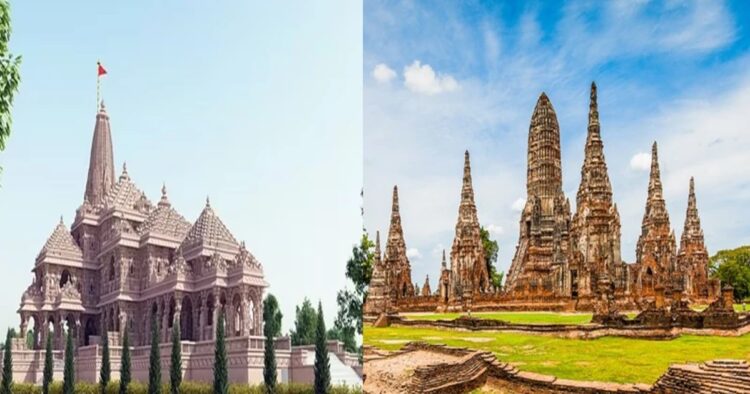In a remarkable display of shared faith and cultural connection, the towns of Ayodhya in Bharat and Ayutthaya in Thailand are gearing up for simultaneous celebrations, echoing the religious fervor of the home of Lord Ram across geographical boundaries.
As Ayodhya eagerly prepares for the consecration of a grand Ram temple just three days away, devotees in Ayutthaya are also joining in the festivities. The Ayodhya temple trust has received significant symbolic contributions from Ayutthaya, including soil named after Ayodhya and water from Thailand’s revered Chao Phraya, Lop Buri, and Pa Sak rivers for the consecration ceremony.
Ayutthaya, a UNESCO World Heritage site nestled along the Chao Phraya River, holds a special place in Thai history and culture. Recognized for its rich cultural heritage, the ancient city stands 70 km north of Bangkok.
In anticipation of the January 22 ‘pran pratishtha’ ceremony in Ayodhya, Hindu temples in Ayutthaya and across Thailand are making elaborate arrangements. Large screens are being set up for the live telecast of the ceremony, allowing devotees to witness the consecration in real-time. Diyas will be lit at temples, and the epic Ramayana will be enacted, accompanied by the singing of Ram bhajans.
Champat Rai, the general secretary of Shri Ram Janmabhoomi Teerth Kshetra Trust, emphasized the significance of Ayutthaya, referring to it as the Ayodhya of Thailand. Holy soil and water from Thai rivers have been received for the ceremony, symbolizing the spiritual connection between the two towns.
Swami Vigyanand, founder and global chairman of the World Hindu Foundation, highlighted the historical connection between Ayutthaya and Ayodhya. King Ramathibodi, the first ruler of Ayutthaya, named the city after Ayodhya, showcasing the influence of the Ramayana on Thai culture.
Ayutthaya, founded in 1350 and once the second capital of the Siamese Kingdom, flourished for centuries before being razed by the Burmese army in 1767. Today, it stands as an archaeological ruin, a testament to its past grandeur and cultural significance.
The impact of the Ramayana in Southeast Asia is evident in the adaptation of the Thai version known as Ramakien, which originated during the Ayutthaya Kingdom. This adaptation reflects the profound influence of Lord Ram’s life on Thai culture.
The cultural ties between Bharat and Thailand extend beyond Ayutthaya and Ayodhya. Both countries share festivals and cultural practices, with Bharat celebrating Kartik Poornima and Dev Deepawali while Thailand marks Loy Krathong, known as the festival of lights. Hindu temples in Thailand are also gearing up for grand celebrations on January 22, aligning with the consecration of the Ram temple in Ayodhya.
The historical and cultural connection between Ayodhya and Ayutthaya serves as a testament to the enduring ties that bind these two distant yet spiritually connected towns. As the first phase of the Ram temple in Ayodhya nears completion, the shared celebrations underscore the universal appeal of the Ramayana and the cultural bonds that transcend borders.

















Comments